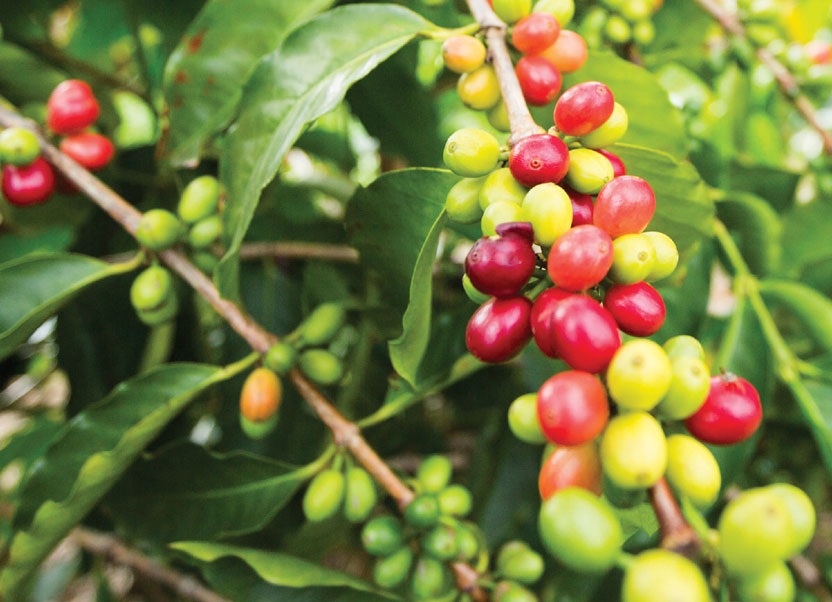A Brief History Coffee
In 1813, during the last years of the reign of Kamehameha I, the Spaniard Don Francisco de Paula Marin introduced coffee plants to his exuberant gardens on O’ahu. It wasn’t long before others started planting the pretty ornamental as well. In 1828, missionary Samuel Ruggles brought cuttings from O’ahu to his land in the Kona District south of Kailua, where he was stationed. Coffee prefers shade and dry, cool summers. It did well on Hawai’i Island’s southwestern volcanic slopes, where clouds sweep in during the afternoons, and ocean breezes temper the sun. Within a few years, coffee began its ascent as a commercial crop, grown for its brew, from Kona to Ka’u- and in Ha- makua as well. In 1892, coffee’s pioneers introdu ced a new variety of coffee bean from Guatemala, Typica. Belonging to the Coffee arabica species, this cultivar showed enormous promise and is still used today.
ced a new variety of coffee bean from Guatemala, Typica. Belonging to the Coffee arabica species, this cultivar showed enormous promise and is still used today.
In Kona, coffee followed a different path than elsewhere, where sugar was king. Few other crops besides coffee fared well in the area’s rocky soils, so Kona was far more determined to turn coffee into a healthy industry. Unfortunately, Hawaiian coffee was subject to global market fluctuations, causing a tumultuous legacy. World coffee prices frequently tumbled, and Kona’s small coffee farmers would largely pay the difference. They would run into major debts with the area’s two dominant mills. Efforts to stabilize sales and prices for Kona’s farmers in the late 1960s, by supplying beans for mainland “Kona Coffee” blends didn’t help much.
A change came in the 1980s, when consumers were ready to appreciate specialty coffees and locally grown products. Independence from the world market became possible. Just around that time, sugar cane, which had covered farm lands in Ha-ma-kua and Ka’u-, began to phase out. The timing was perfect for coffee to bloom as a premium Hawai’i crop, not just in Kona but island-wide.
Ka’u-, for sure, was ready. Majestic Mauna Loa provides fertile soil and ideal cloud cover conditions around Pa-hala. Many farmers had maintained their Coffee Arabica trees from earlier days, knowing that they delivered superior quality. They began to focus on creating the world’s best roasts. Coffee invigorates a tradition of agriculture for Ka’u- into the future. In the early 2000s, Ka’u- coffee began proudly showing its strength in cupping sessions worldwide, and small farms in Ka’u- began garnering awards. The first Ka’u- Coffee Festival launched in 2009.

In Hawai’i, the coffee harvest takes place about eight months after flowering, beginning in late fall. A healthy tree can yield from ten to fifteen pounds of cherries. But the journey from cherry (coffee fruit) to brew is complex, requiring much more. Healthy soils, cooling winds sufficient water, sunshine, shade, and also human skill blend in each great cup. From seed to cup, processing coffee depends in part on what is desired. Cherries are usually washed before drying to remove fruit skins and pulp, which provides a clean flavor. A semi-wash keeps some pulp on the bean during drying. When both fruit and skin fully remain, a wilder, fruity flavor results, called natural or non- washed. Drying occurs on large, sunny platforms. Next, hulling removes the beans’ parchment-like paper (and any skin or fruit), rendering green beans ready for sorting. This is the time to separate prized peaberries, coffee beans that are round because only one seed, rather than the usual two, developed in the fruit. Beans may now be roasted to medium, medium dark, dark, and extra dark roasts.
Founded by Ed Olson, Ka’u- Coffee Mill in Pa-hala currently tends to about 60 acres in coffee orchards. It is fortunate to be able to replenish the soil continuously with mulching and compost derived from macadamia nut husks produced by other Trust farms. Water supplementing Ka’u-’s rainfall comes from a restored plantation system. The Mill processes, roasts, and packages coffee beans grown on its own acreage and also makes these complete services, as well as irrigation water, available to approximately 80 other growers in Ka’u-.
